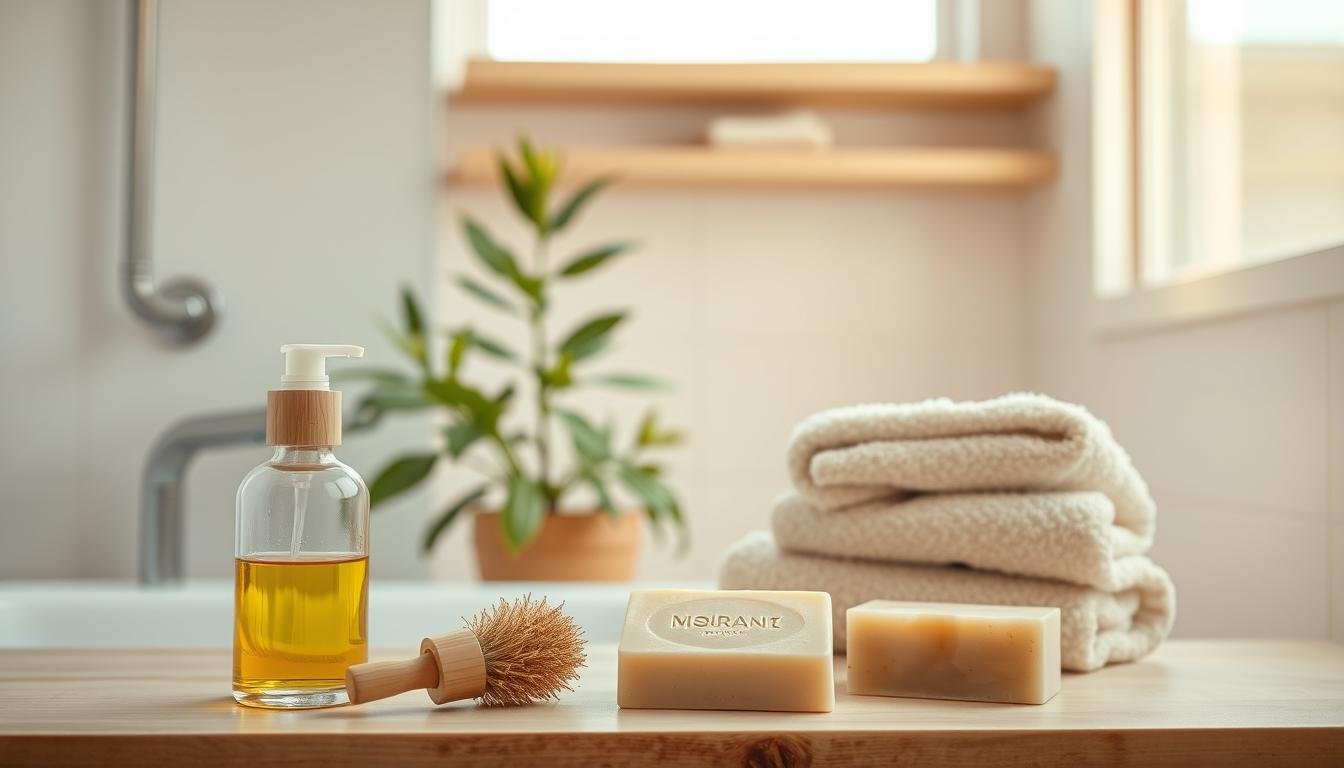What if your daily skincare routine could help slow climate change? While it might sound dramatic, the products you use every morning have a bigger environmental impact than you realize. The beauty industry produces over 8 billion plastic containers annually in the U.S. alone—enough to circle the Earth twice. With global waste reaching crisis levels, your personal care habits matter more than ever.
You don’t need to abandon lipstick or ditch your favorite moisturizer to make a difference. Small shifts in your regimen—like opting for refillable containers or supporting brands that prioritize recyclable materials—add up fast. Experts confirm that conscious consumer choices can reduce landfill waste by up to 30% within a single household.
This isn’t about perfection. It’s about progress. Whether you’re a skincare enthusiast or a minimalist, you’ll find realistic ways to align your routine with your values. Let’s explore how simple swaps can protect both your skin and the planet—starting today.
Key Takeaways
- The beauty industry generates billions of non-recyclable packaging units yearly
- Small daily changes create measurable environmental benefits over time
- Sustainability doesn’t require sacrificing product quality or personal style
- Refillable containers and biodegradable materials significantly cut waste
- Consumer demand drives brands to adopt greener practices faster
Understanding the Environmental Impact of Beauty Products
Behind the glossy packaging of your favorite items lies an environmental story few discuss. The beauty industry generates enough plastic containers each year to fill 1,000 Olympic pools—and that’s just in America. Most containers never get recycled, ending up in landfills or floating in oceans for centuries.

Plastic Waste and Packaging Challenges
Single-use tubes and compacts create mountains of trash. Less than 9% of plastic packaging actually gets repurposed. The rest breaks into microplastics that poison fish and seep into drinking water. Even “recyclable” containers often get trashed due to mixed materials or residue.
Harmful Ingredients and Their Effects
Many products contain chemicals that linger long after you rinse them off. Parabens mimic estrogen in aquatic life, while formaldehyde releases toxic fumes during production. These ingredients don’t just vanish—they flow into rivers, harming ecosystems and accumulating in food chains.
Manufacturing processes also pump carbon dioxide into the air. From sourcing raw materials to shipping final goods, every step leaves a mark. Choosing cleaner formulas and reusable containers helps shrink this footprint without sacrificing results.
Assessing Your Current Beauty Routine for Sustainability
Your daily regimen holds hidden opportunities to reduce waste. Start by laying out every item in your collection. Sustainability expert Ashlee Piper suggests asking: “Does this product spark joy—or dust?” You might find half-used serums or duplicate cleansers hiding in plain sight.

Evaluating Product Usage and Waste
Track what you actually use for two weeks. Note which items stay untouched. Most people only regularly use 20% of their skincare stash—the rest becomes landfill fodder. Focus on your skin’s core needs rather than trendy purchases.
Create a simple table to spot patterns. This helps identify impulse buys and expired products:
| Product Type | Average Usage Rate | Annual Waste Impact |
|---|---|---|
| Moisturizers | 85% used | Low |
| Lipsticks | 32% used | High (plastic tubes) |
| Face Masks | 45% used | Medium (packaging) |
| Serums | 68% used | Moderate |
Ask three questions before buying new items: “Do I own something similar?”, “Will I finish this?”, and “Can I recycle the packaging?” Consolidate multi-use products—a tinted moisturizer can replace separate SPF and foundation bottles.
Set monthly reminders to check expiration dates. Rotate seasonal items to the front of your shelf. This simple habit prevents waste and saves money over time.
Incorporating eco-friendly beauty tips into Your Routine
Transforming your daily regimen starts with rethinking consumption habits. Sustainability expert Ashlee Piper reminds us: “The greenest product is the one already in your cabinet.” Before hunting for new items, explore creative ways to maximize what’s in your stash.

Utilizing What You Already Have
Finish that half-empty serum gathering dust. Mix unused lotions into body oils or turn dried mascara into temporary brow tint. Local Buy Nothing groups breathe new life into barely-used items—65% of members report successfully rehoming cosmetics.
Choosing Sustainable Alternatives
When replacements become necessary, prioritize companies using refill systems or biodegradable materials. Glass jars and aluminum tubes outlive plastic counterparts by decades. Cross-check ingredients through the EWG database—look for plant-based formulas free from synthetic preservatives.
Build your transition gradually. Start by swapping one frequently used item monthly. Many brands now offer sample sizes to test compatibility before committing. This phased approach prevents overwhelm while steadily reducing your environmental footprint.
Sustainable Product Choices and Smart Packaging
The future of conscious consumption starts with what you buy—and how it’s wrapped. Packaging accounts for 70% of the beauty industry’s waste, but innovative solutions are changing the game. From refillable compacts to plant-based materials, smarter choices exist for every step of your routine.
Refillable and Reusable Packaging
RMS Beauty proves materials matter—their glass jars with PCR plastic lids cut waste by 67-79% compared to traditional options. Kjaer Weis takes it further with luxe metal lipstick cases you refill endlessly. “Refill systems aren’t trends—they’re necessities,” says CEO Kirsten Kjaer Weis.
Eco-Conscious Ingredient Selection
Look beyond marketing claims. Truly sustainable ingredients come from wildcrafted plants or organic farms. Innersense uses responsibly sourced shea butter, while Aveda’s formulas meet strict Environmental Working Group standards. Always check for third-party certifications like Ecocert.
Supporting Ethical Brands and Initiatives
Patagonia-backed B Corp brands like Credo lead the charge. They prioritize renewable energy and donate profits to ocean cleanup. When you support brands with transparent practices, you fund real change—not just greenwashed promises.
Start small: swap one plastic-packed product monthly. Try Ethique’s shampoo bars or Lush’s naked serums. Your choices tell companies what matters—use that power wisely.
Minimizing Waste and Embracing Multi-Use Products
What if your makeup bag could shrink by half while helping the planet? Single-use items like disposable wipes create 8,000 tons of landfill waste daily. Sustainability expert Jhánneu puts it bluntly: “Less is more—your cheeks don’t need three separate products when one does it all.”
Double-Duty Products for a Streamlined Routine
Swap that lipstick-bronzer-blush trio for one creamy pigment. Jillian Dempsey’s Cheek & Lip Tint works on eyelids too—no extra brushes needed. RMS Beauty’s Lip2Cheek lasts 18 months and replaces four single-purpose products in your collection.
Check your current makeup for hidden versatility. That shimmery highlighter? Dab it on collarbones as body glitter. Use matte eyeshadow to fill brows or contour cheeks. You’ll declutter your shelf and slash plastic waste from duplicate packaging.
| Multi-Use Product | Replaces | Annual Waste Saved |
|---|---|---|
| Exa Light Show Pigment | Eyeshadow + Highlighter + Lip Gloss | 11 plastic containers |
| RMS Luminizer | Highlighter + Eyeshadow + Face Primer | 9 containers |
| Ilia Multi-Stick | Blush + Lip Color + Eyeshadow | 7 tubes/pots |
Mia Davis, cosmetic sustainability researcher, notes: “One quality multi-tasker outperforms three mediocre singles.” Prioritize cream-based formulas—they blend easily across skin types and last longer than powders. You’ll save money and counter space while keeping microplastics out of oceans.
Next time you shop, ask: “Can this product serve two purposes minimum?” Your streamlined routine will thank you—and so will sea turtles.
Creating a More Sustainable Bathroom Environment
Your bathroom holds untapped potential for reducing household waste. Simple swaps in this space can eliminate hundreds of disposable items annually while maintaining your personal care standards. Let’s explore upgrades that work as hard as your favorite skincare essentials.
Swapping Disposable for Reusable Tools
Ditch single-use razors and plastic-packed products. Stainless steel shavers with replaceable blades last years, while tooth tabs in glass jars cut plastic waste by 90%. Brands like LastSwab offer silicone cotton swabs designed for 1,000+ uses—ideal for precise makeup fixes or ear cleaning.
Eco-Conscious Bathroom Accessories
Upgrade your routine with Clean Circle’s bamboo charcoal makeup pads. These alternatives remove stubborn mascara better than disposable wipes, washing clean for repeated use. Pair them with Tushy’s bidet attachment to reduce toilet paper consumption—Reel’s bamboo rolls handle the rest sustainably.
Small changes create big impact. Start with one swap this week, like trying shampoo bars or menstrual cups. Your choices today shape tomorrow’s landfills—make them count without compromising on quality.



